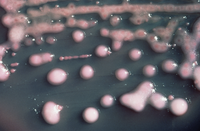
Photo from wikipedia
Extended spectrum β-lactamase producing Escherichia coli (ESBL-EC) are excreted via effluents and sewage into the environment where they can re-contaminate humans and animals. The aim of this observational study was… Click to show full abstract
Extended spectrum β-lactamase producing Escherichia coli (ESBL-EC) are excreted via effluents and sewage into the environment where they can re-contaminate humans and animals. The aim of this observational study was to detect and quantify ESBL-EC in recreational water and wastewater, and perform a genetic and phenotypic comparative analysis of the environmental strains with geographically associated human urinary ESBL-EC. Recreational fresh- and saltwater samples from four different beaches and wastewater samples from a nearby sewage plant were filtered and cultured on differential and ESBL-selective media. After antimicrobial susceptibility testing and multi-locus variable number of tandem repeats assay (MLVA), selected ESBL-EC strains from recreational water were characterized by whole genome sequencing (WGS) and compared to wastewater and human urine isolates from people living in the same area. We detected ESBL-EC in recreational water samples on 8/20 occasions (40%), representing all sites. The ratio of ESBL-EC to total number of E. coli colony forming units varied from 0 to 3.8%. ESBL-EC were present in all wastewater samples in ratios of 0.56–0.75%. ST131 was most prevalent in urine and wastewater samples, while ST10 dominated in water samples. Eight STs and identical ESBL-EC MLVA-types were detected in all compartments. Clinical ESBL-EC isolates were more likely to be multidrug-resistant (p<0.001). This study confirms that ESBL-EC, including those that are capable of causing human infection, are present in recreational waters where there is a potential for human exposure and subsequent gut colonisation and infection in bathers. Multidrug-resistant E. coli strains are present in urban aquatic environments even in countries where antibiotic consumption in both humans and animals is highly restricted.
Journal Title: PLoS ONE
Year Published: 2017
Link to full text (if available)
Share on Social Media: Sign Up to like & get
recommendations!